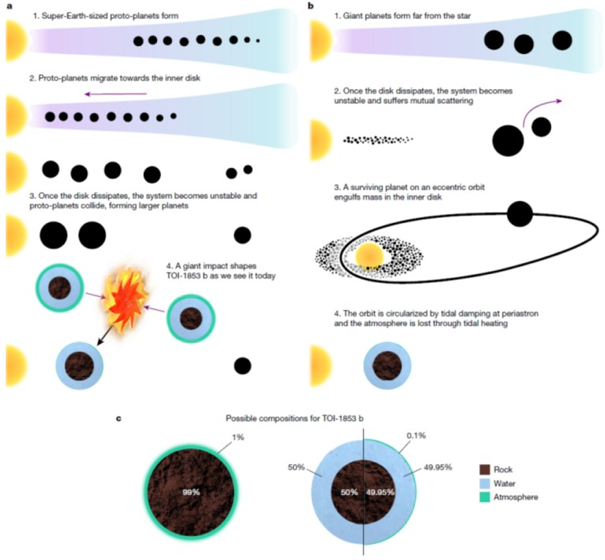by Alessandro Sozzetti
An international team of scientists led by the University of Rome Tor Vergata and by INAF, which also includes Alessandro Sozzetti, Aldo Bonomo, etc. of the Turin Astrophysical Observatory (INAF-OATo) has discovered an exoplanet with extraordinary characteristics – identified thanks to NASA’s TESS satellite and characterized with the HARPS-N spectrograph installed at the Galileo National Telescope – whose physical properties challenge conventional theories of planetary formation and evolution.
It is called TOI-1853b and it is extremely peculiar: every 30 hours it completes a complete revolution around its star, it has a radius comparable to that of Neptune (3.5 terrestrial radii), but a mass about four times greater (73 Earth masses, 80% of the mass of Saturn). This gives it the record of the highest density among the Neptunian exoplanets known to date (about 10 g/cm3, double the density of the Earth).
545 light-years away from us, it is in the so-called ‘Desert of the Neptunians‘, a region close to the stars in which planets of the size of Neptune are not found: receiving a strong irradiation from the star, these planets cannot retain their gaseous atmospheres that evaporate, thus leaving exposed a solid core much smaller than Neptune’s in size. Based on theories of planetary formation and evolution, it was not expected that such a planet could exist so close to its star.
The high density of TOI-1853b makes it difficult to pinpoint its exact composition. It may have a rocky core surrounded by a small gaseous envelope of hydrogen and helium which makes up at most 1% of the planet’s mass. Another very fascinating hypothesis is that it could be composed of half rocks and half water ice. Given the high temperature of the planet (about 1500 degrees Kelvin), in this second case TOI-1853b could have an atmosphere rich in water vapour.
Extreme scenarios must be invoked to explain its existence. Its origin could be due to collisions between massive protoplanets in the original proto-protoplanetary disk. Such clashes could have removed almost all the planet’s atmosphere, which would explain its small size and high density, as if only the planet’s bare core was left behind. Alternatively, TOI-1853b may have initially been a gas giant like Jupiter (or more massive) and would have assumed a highly elliptical orbit following dynamical instabilities due to gravitational interactions with other planets. This would have led it to orbit very close to its star, which would have caused it to lose its outer atmospheric layers and would, at the same time, have circularized and stabilized its orbit at the current distance from its star.
For more information it is possible to read the article published in Nature:
- “A super-massive Neptune-sized planet”, by Luca Naponiello with Alessandro Sozzetti, Aldo S. Bonomo, Patricio E. Cubillos, Matteo Pinamonti, Mario Damasso, Paolo Giacobbe and Gloria Guilluy, Nature (2023).
-
Il nettuniano più denso mai osservato (Media INAF article, in Italian)

Possible formation scenarios and final composition for TOI-1853b.
Credits: Naponiello et al 2023, Nature
